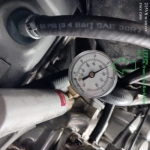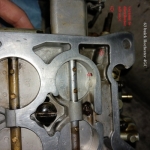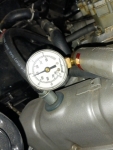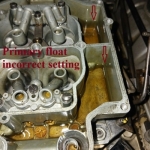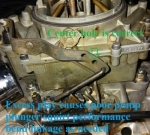Symptom: transition from idle to part throttle hesitation under load and stalling under snap of throttle
Checked and verified 63 Service manual specs 215V8:Timing set 5 degrees, no vacuum advance, plugged line from aluminum base of 4gc rochester. Tach 500 rpms for automatic.
Vacuum line from carb base showing 17 in. ,with specs calling for min. @14 in.
Engine is fitted with StreetRace cam, just one above stock, mild increase therefore 17 in. vs. =>18 in. vacuum. Pertronix igniter fitted instead of points. Carb, has been kept up, base set,mixture, etc.
Concern: vacuum advance begins to pull(doesnt leak) at 10 in. and max pull at 18 in ,this is normal. Now, the problem is at idle my vacuum advance is applying max pull, because i have 17 in. Vacuum from my throttle valve the base plate the only fitting for this on 4GC. So, my idle rpms go to 600 from base of 500 with advance plugged in. I can see it in the timing advancing more than 10 degrees. (irrelevent) dont know amount i have Sears inductive with no adjustable reading.
SUMMARY: The vacuum advance comes in at part throttle and turns off at WOT, and it should not be at maximum advance at idle because it will prematurely activate the advance.
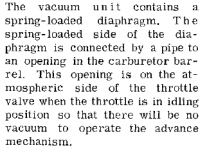
1963 Buick Chassis Service manual, page 10-33.
Timing & Vacuum Advance 101 -good article by GM engineer
Checked and verified 63 Service manual specs 215V8:Timing set 5 degrees, no vacuum advance, plugged line from aluminum base of 4gc rochester. Tach 500 rpms for automatic.
Vacuum line from carb base showing 17 in. ,with specs calling for min. @14 in.
Engine is fitted with StreetRace cam, just one above stock, mild increase therefore 17 in. vs. =>18 in. vacuum. Pertronix igniter fitted instead of points. Carb, has been kept up, base set,mixture, etc.
Concern: vacuum advance begins to pull(doesnt leak) at 10 in. and max pull at 18 in ,this is normal. Now, the problem is at idle my vacuum advance is applying max pull, because i have 17 in. Vacuum from my throttle valve the base plate the only fitting for this on 4GC. So, my idle rpms go to 600 from base of 500 with advance plugged in. I can see it in the timing advancing more than 10 degrees. (irrelevent) dont know amount i have Sears inductive with no adjustable reading.
SUMMARY: The vacuum advance comes in at part throttle and turns off at WOT, and it should not be at maximum advance at idle because it will prematurely activate the advance.

1963 Buick Chassis Service manual, page 10-33.
Timing & Vacuum Advance 101 -good article by GM engineer
Last edited:


